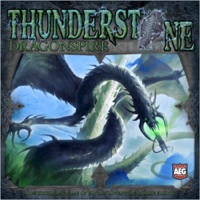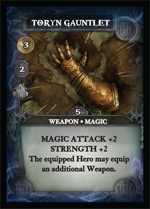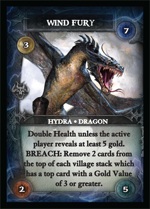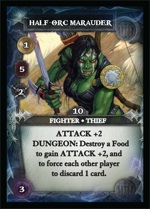
|
About OgreCave and its staff
|

|
by Lee Valentine
Thunderstone: Dragonspire ("DS") is the newest expansion for AEG's hit deck-building card game Thunderstone ("TS"). DS is playable as a stand-alone game as well, the first such TS expansion to have that feature. I refer you to my original TS review for information on how the game is played. In this review, I will be focusing a bit on the box's contents and what this set will add to the environment.
New Additions to the Game
A number of the new village cards in this set take some work to make them useful. For instance, some manipulate which monsters are in the Dungeon or the cards you will have in your next hand. While these may bewilder beginners, experienced TS players will enjoy the challenge and options presented by these cards. A handful of cards also have potentially random effects that are triggered based on the type of card discarded from the top of your own deck or your opponent's. Sometimes you can manipulate your own deck to have more control over these effects, but other times they are just random. In a game that relies so thoroughly on mathematical calculations, players will either find these types of cards novel, or an unreliable addition to a game that demands more reliability. One of the new Village cards, a weapon called the Toryn Gauntlet, increases a Hero's Strength, allows him to wield an additional weapon (presumably including another Toryn Gauntlet), and grants a bonus to attack. Combined with a high base gold value, this card seemed almost too good to be true compared to many other weapons already printed.
This set is particularly dangerous for the dungeon delvers. Something always seems to be destroying your weapons or heroes. The monsters are often extremely challenging, sometimes requiring that multiple Heroes and weapons be destroyed after just a single encounter. This means that entering the Dungeon is not for the faint of heart. Thunderstone, like a number of other deck-building games including Dominion, has an initial marketplace of cards for players to purchase "in game", the contents of which are determined randomly using special decks of randomizers. As I noted in my review of the TS base set, I thought it was a substantial error to give the randomizers used in TS an identical back to the other cards used in the game. AEG has finally gotten around to fixing this issue in DS. In this set, AEG has reprinted randomizers for all the editions of TS released to date. This time, their backs have minor differences to help separate them from core game cards. Oddly, though, the superior packaging and indexing system in this edition (compared to the base game) means this change is still a good one, but one substantially less necessary than in the original edition. One big oversight here was a failure to mark the randomizers with a set-specific icon. Why would this be useful? DS is meant to be playable as a stand-alone set, yet you can only identify the DS-specific cards by inventorying your set. With sorting icons, you could easily choose which expansions to play with and pull the appropriate randomizers for those expansions.
Rules Clarity A new game variant featuring cooperative play was described in a fairly murky fashion, leaving me initially puzzled over how it worked. The rulebook also features a new solo variant to try, but to use this variant you either have to download the core solo play rules online or own Wrath of the Elements. Unfortunately, the card glossary does not cover all of the cards, and oddly sometimes covered the more obvious cards rather than the more troublesome ones. This is a particular issue because this expansion has more vaguely worded cards than most of the other expansions. With some cards I could correctly divine the intent even though the cards were not worded in a crystal clear fashion. At least one card I would have had no idea how to handle had I not seen a somewhat similar card (with clearer wording) in the original TS set. Still another card I have no clear idea of what it does and how it works.
Components The stock used for the playing cards was of similarly good quality to that found in the previous TS sets. However, very minor deviations in the length of some cards in the set might cause occasional problems with riffle shuffling. I was not pleased with the collation in this edition. I spent quite a lot of time separating cards out, sorting them by type, and arranging them to put them into the box. One thing that spending that time counting and sorting the cards did clue me in on was that the numbers of some basic cards (Dagger, Iron Rations, and Torch) have changed. In the base TS set there are 15 each of these, allowing each player in a five-player game to have two each plus five leftover for purchase. DS ships with only ten of each of these cards, meaning that in a five-player game there are no leftovers for purchase. I did not find this information highlighted in the rulebook, but it is an important change; I presume also that the change was an intentional one.
The final new components introduced in DS are small Thunderstone-shaped plastic tokens to be used to track Experience Points ("XP"). These are fantastically useful. The original edition of TS used XP cards to track this information. This was one more pile of cards to keep track of, and you could not tell how many XP you had at a glance. Now you can. This is a very welcome addition to gameplay.
Packaging Leaving out older basic cards and diseases (in favor of the new versions of them from DS) I was able to fit all the TS cards produced to date into the DS box. There was not a lot of space leftover, however, and so I have my doubts as to whether you could sleeve all your cards and still fit everything.
Conclusions
For Retailers
Lee's Ratings
Links:
|
||||
 Thunderstone: Dragonspire
Thunderstone: Dragonspire There's a good mix of Heroes, Monsters, and Village cards in DS,
almost as many of each as were in the game's original base set. There
is plenty of card diversity to allow for a lot of replay value.
There's a good mix of Heroes, Monsters, and Village cards in DS,
almost as many of each as were in the game's original base set. There
is plenty of card diversity to allow for a lot of replay value.
 The new heroes offer a variety of new abilities. However, other than
forcing some occasional discards, the set continues to limit
player-versus-player interaction. Two new heroes are noteworthy. The
Veteran class has four different levels of heroes to advance to instead
of the normal three. While there are only two levels of Phalanx heroes,
the more Phalanx heroes you have the more powerful they all become.
The new heroes offer a variety of new abilities. However, other than
forcing some occasional discards, the set continues to limit
player-versus-player interaction. Two new heroes are noteworthy. The
Veteran class has four different levels of heroes to advance to instead
of the normal three. While there are only two levels of Phalanx heroes,
the more Phalanx heroes you have the more powerful they all become.
 Another new addition to the game in this expansion is a board to track
which ranks of the dungeon hold which monsters. Dungeon rank (or
"level" in RPG parlance) is not a complex mechanic to begin with. If a
board was required for this purpose, it would only be necessary for
beginning players. The light penalties mechanic, however, can be very
troubling to keep track of. While the new dungeon board lists the
standard light penalties for each rank, the font effects applied to the
typography make the relevant text quite difficult to read. Furthermore,
even within this set there are creatures that cause significant
modifications to light penalties, including some that globally cause
changes to light penalty calculations for the whole dungeon, rendering
the information on the board useless when those creatures are in play.
As a result, the board is more novel than it is useful. A set of
counters with "-2" printed on them to help calculate attack penalties
due to darkness would have been helpful. I have handcrafted just such
things myself and have used them ever since I started playing TS.
Another new addition to the game in this expansion is a board to track
which ranks of the dungeon hold which monsters. Dungeon rank (or
"level" in RPG parlance) is not a complex mechanic to begin with. If a
board was required for this purpose, it would only be necessary for
beginning players. The light penalties mechanic, however, can be very
troubling to keep track of. While the new dungeon board lists the
standard light penalties for each rank, the font effects applied to the
typography make the relevant text quite difficult to read. Furthermore,
even within this set there are creatures that cause significant
modifications to light penalties, including some that globally cause
changes to light penalty calculations for the whole dungeon, rendering
the information on the board useless when those creatures are in play.
As a result, the board is more novel than it is useful. A set of
counters with "-2" printed on them to help calculate attack penalties
due to darkness would have been helpful. I have handcrafted just such
things myself and have used them ever since I started playing TS.